PROTECT YOUR DNA WITH QUANTUM TECHNOLOGY
Orgo-Life the new way to the future Advertising by AdpathwayThe sweet potato harvest in late summer makes the season’s end a little more palatable. After a long development, we can look forward to sweet and savory combinations with the hearty, earthy roots.
The sizeable, tuberous roots are a filling, nutritious, easy-to-grow crop. They produce high yields in containers, raised beds, or even along walkways as a vining groundcover.
The crop takes about three months to mature, though in the right spot, it needs little tending as the roots develop underground. As we approach September and October, get ready to harvest the season’s bounty.
We’ll outline when to harvest sweet potatoes at peak flavor and texture. The long-storing potatoes are prepared to serve up goodness all winter and beyond.
Growing Sweet Potatoes
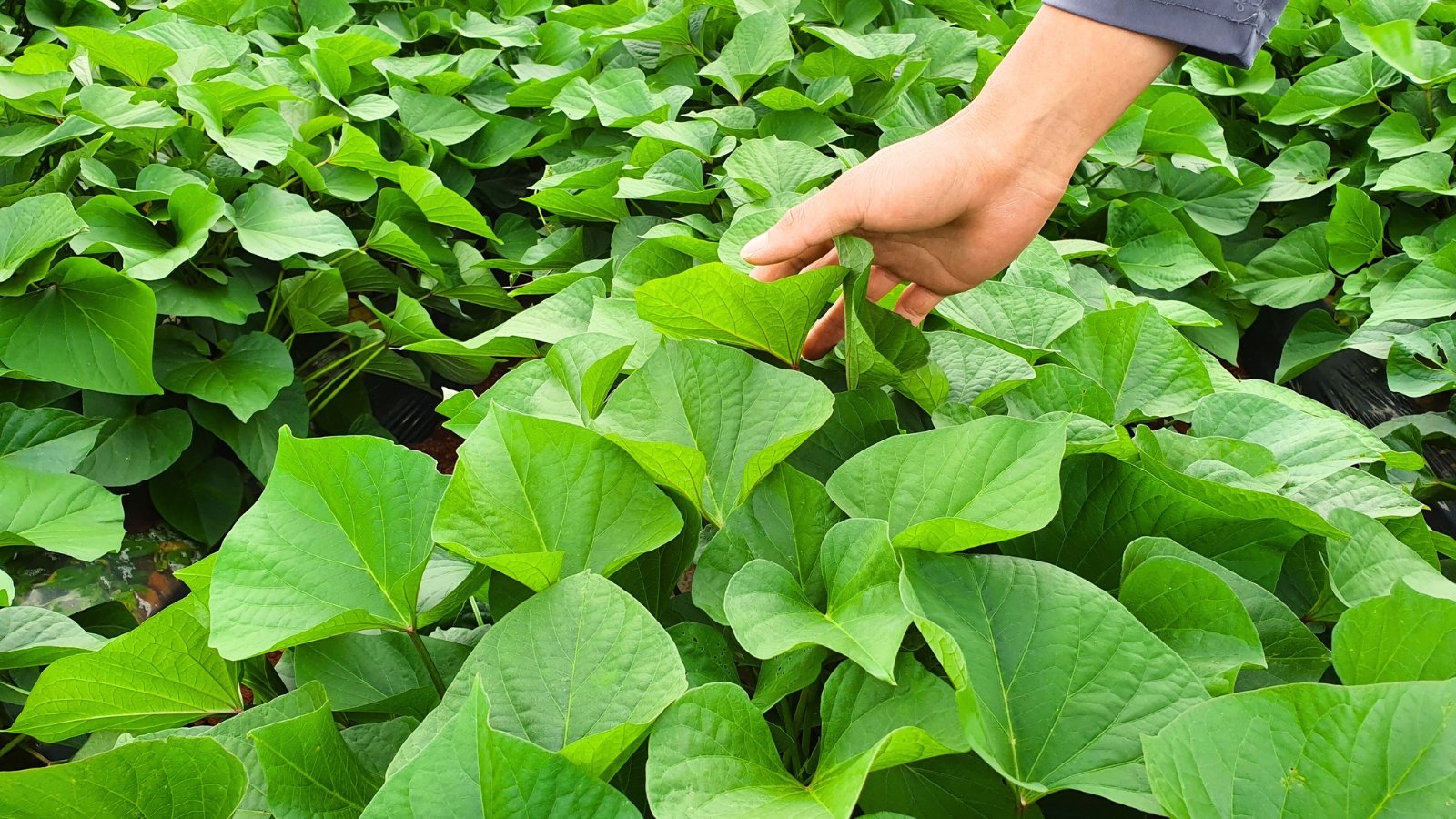 Loose sandy soil helps roots grow big and healthy.
Loose sandy soil helps roots grow big and healthy.Sweet potatoes (Ipomoea batatas) are nutritional powerhouses that make their long development well worth the wait. They’re a source of calcium, potassium, and vitamins A and C, in addition to fiber.
Big and filling, they go a long way on the plate and have a long storage life. Young, tender leaves are edible too. Enjoy them fresh or cooked, picking some and leaving others on the vine to support the roots.
Sweet potatoes sprout from “slips,” or eyes from the main root, planted in spring or summer. The warm-season annuals are frost-sensitive and rely on mild temperatures to grow. Plant potatoes after the threat of frost passes and as the soil warms to at least 65°F (18°C) in spring.
Optimal growing conditions for the easy crops include:
- Full sun with six or more hours daily.
- One inch of water per week with consistent moisture, especially in the first four to six weeks, as roots develop; withhold water in the final few days before harvesting.
- Loose, loamy, sandy, and well-draining soil.
- Plant in mounds or ridges for good root space, drainage, and easy harvesting.
- Keep the area weed-free to reduce competition.
Gauge the Days to Maturity
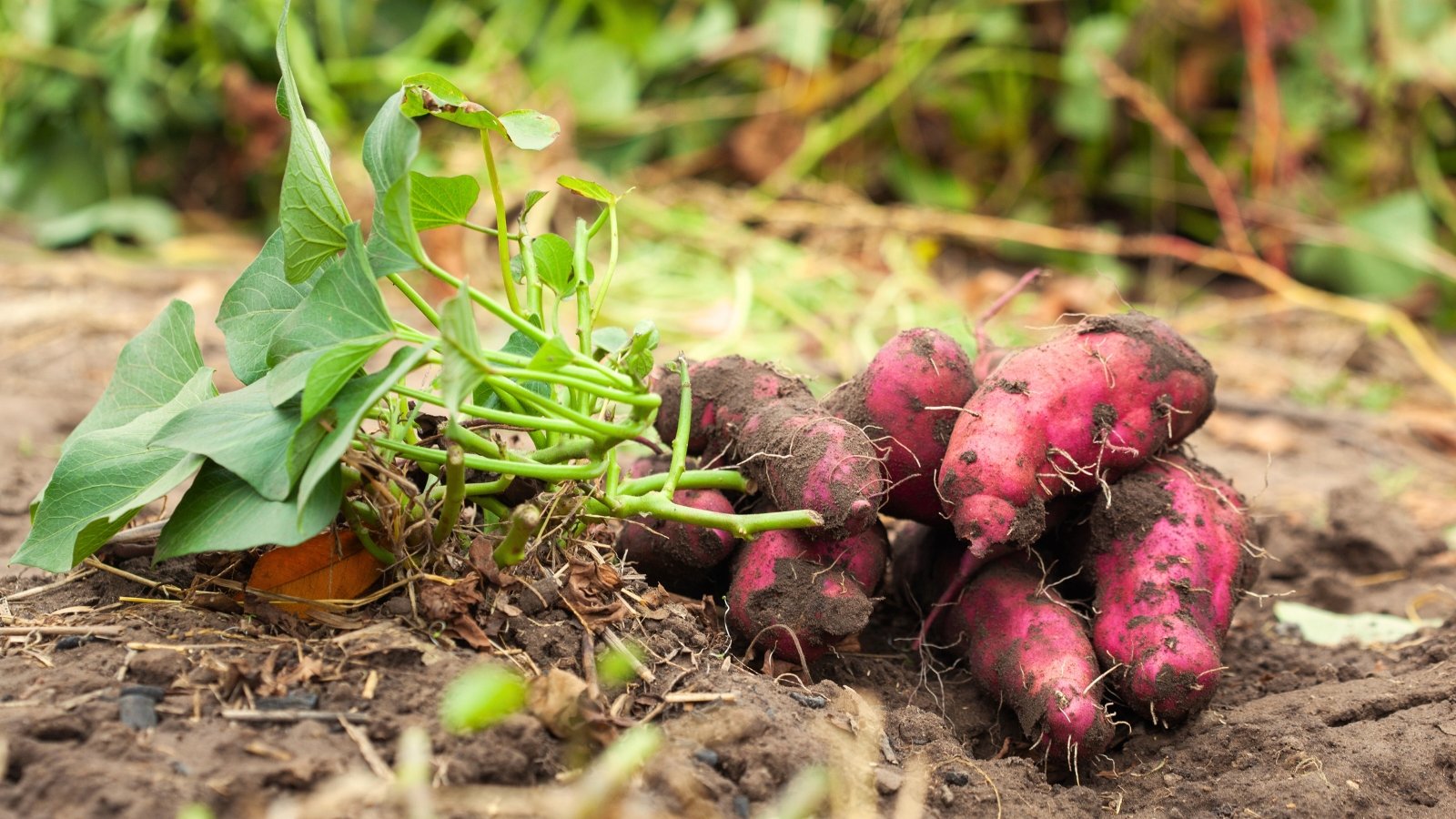 Watch closely near maturity to catch perfect harvest.
Watch closely near maturity to catch perfect harvest.Sweet potatoes are long maturing to develop their dense, large, tuberous roots. Depending on the variety, they mature in about 85 to 120 days. The first way to gauge if sweet potatoes are ready to harvest is to know the length of time it takes the variety to mature.
The days to maturity for each variety are an estimate based on optimal growing conditions. We can usually add a few extra days to a week to account for weather fluctuations, but it’s the starting point of when a spud reaches full size.
The days to maturity timeframe is a guide to use in combination with key physical signs. Check a few days before the maturity date, and keep checking in the days following for readiness. Sweet potatoes continue growing and can crack and split when they overgrow.
At planting, count out to the estimated date they’ll mature (or ask a browser for “X days from today”) and add it to the calendar. Begin checking within the readiness window. Use first and last frost dates as a benchmark for when to sow each season.
Yellowing Leaves
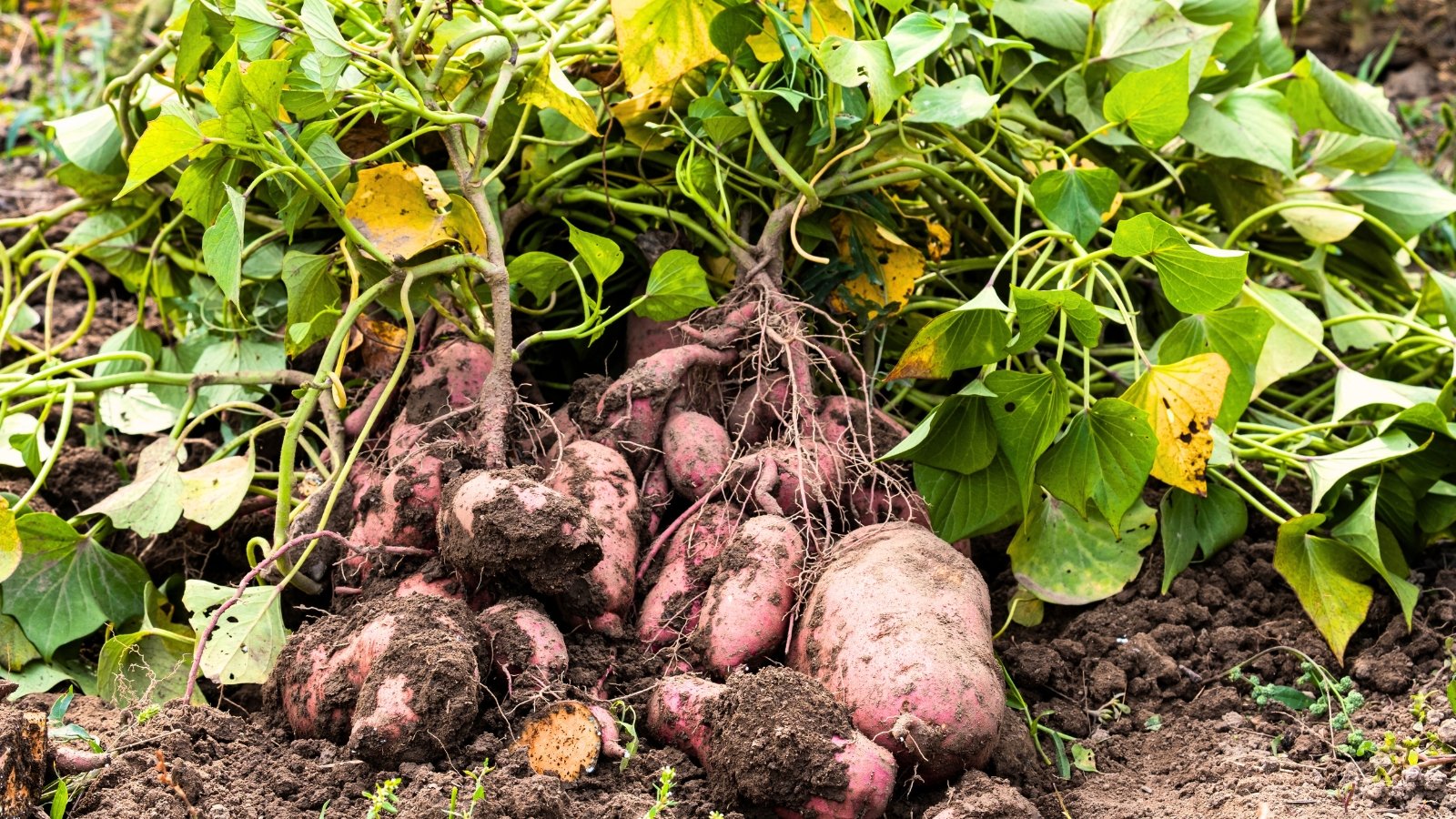 Yellow stems hint that roots are reaching full size.
Yellow stems hint that roots are reaching full size.The leafy vines begin to yellow and wilt at season’s end, as the tuberous roots reach peak readiness. Yellowing leaves around the days to maturity are a strong visual cue that potatoes are ready.
Use yellowing and wilting stems in coordination with other signs of when to harvest sweet potatoes. Sometimes, yellowing occurs prematurely while the spuds continue to reach eating size beneath the surface. Leave in place as yellowing begins to continue growing.
Frost in the Forecast
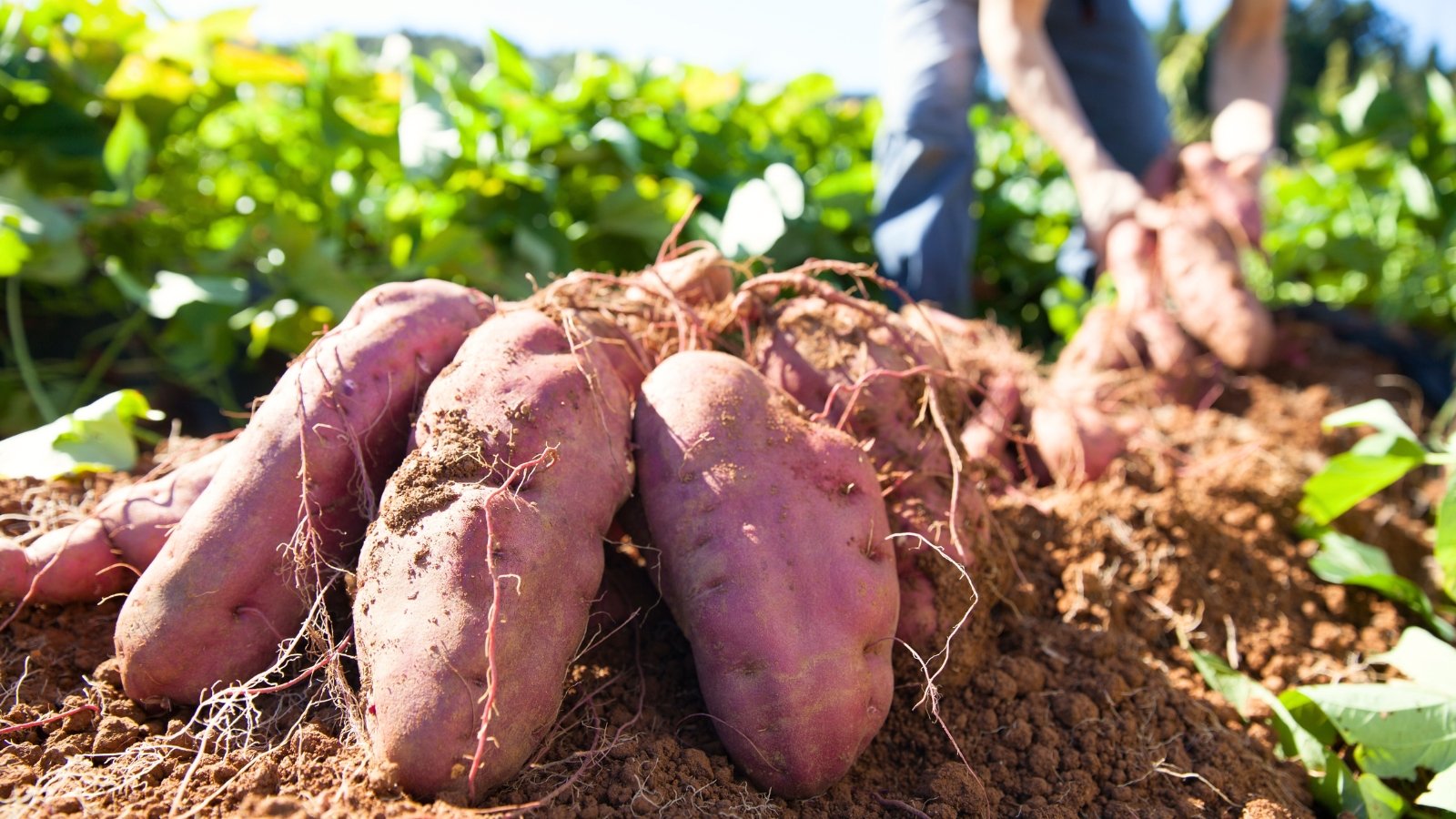 Chilly soil risks root damage, so harvest soon.
Chilly soil risks root damage, so harvest soon.The goal for sweet potatoes is to harvest them at eating size before frost. If the frost-sensitive vines die back in cold weather, the root begins to decay. Pull the sweet potatoes if frost is forecast or right after an early surprise freeze.
If you can’t harvest right away, cut away the vines and cover the crop with soil or compost for insulation. Sweet potatoes are susceptible to cold damage in soil temperatures below 50°F (10°C).
Tuber Check
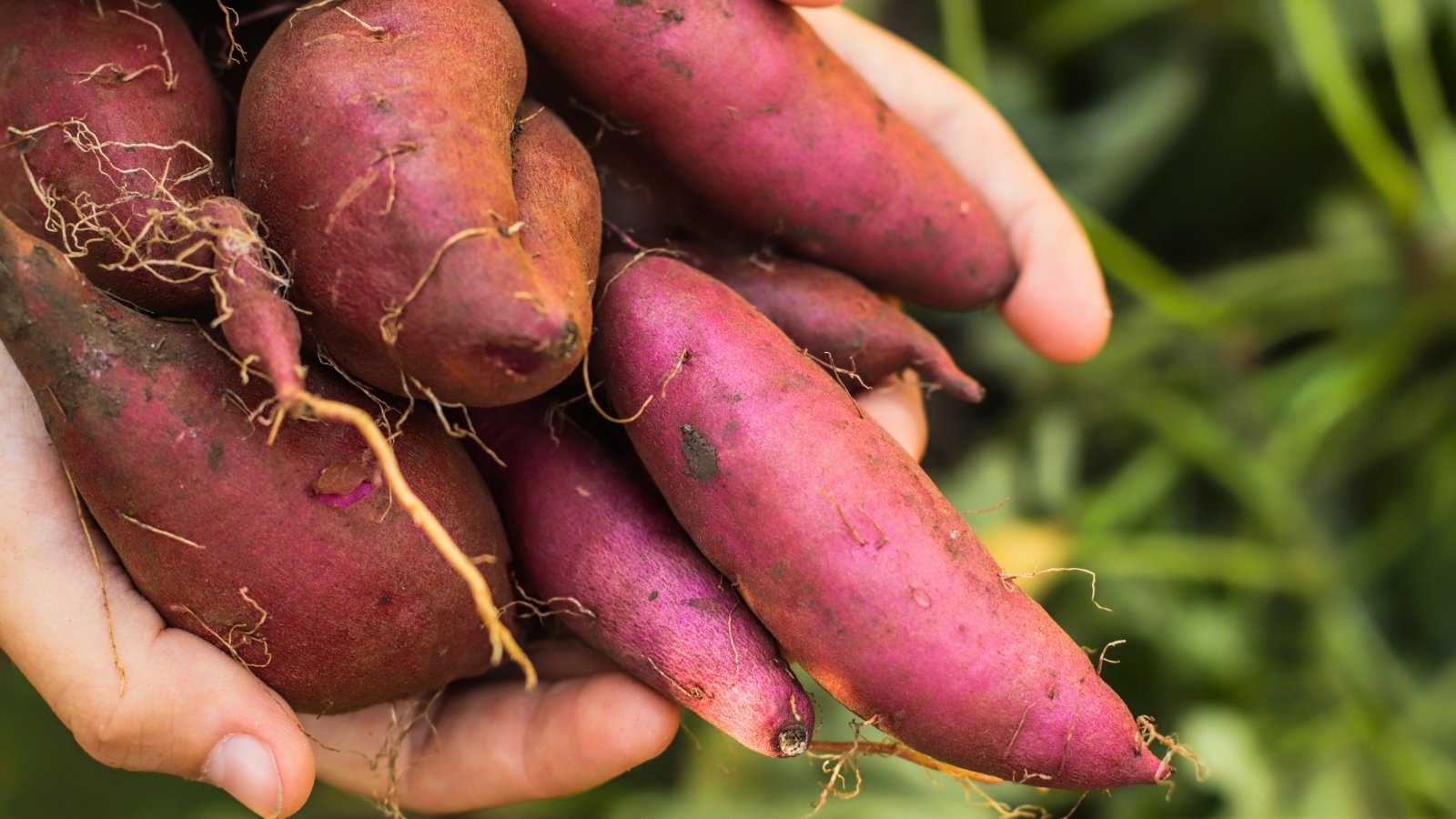 Roots around two inches mean they’re a good size.
Roots around two inches mean they’re a good size.The real guarantee of when sweet potatoes are ready to harvest is to test a couple of the roots to measure their size. Generally, full size is about two inches in diameter and five inches long. If the variety is near the days to maturity window and leaves are yellowing, checking regularly is a good measure.
Check all points along the stem, too, when digging for smaller roots. “Baby bakers” develop as the vines root in place, though not as large as the regular planted slips.
How to Harvest
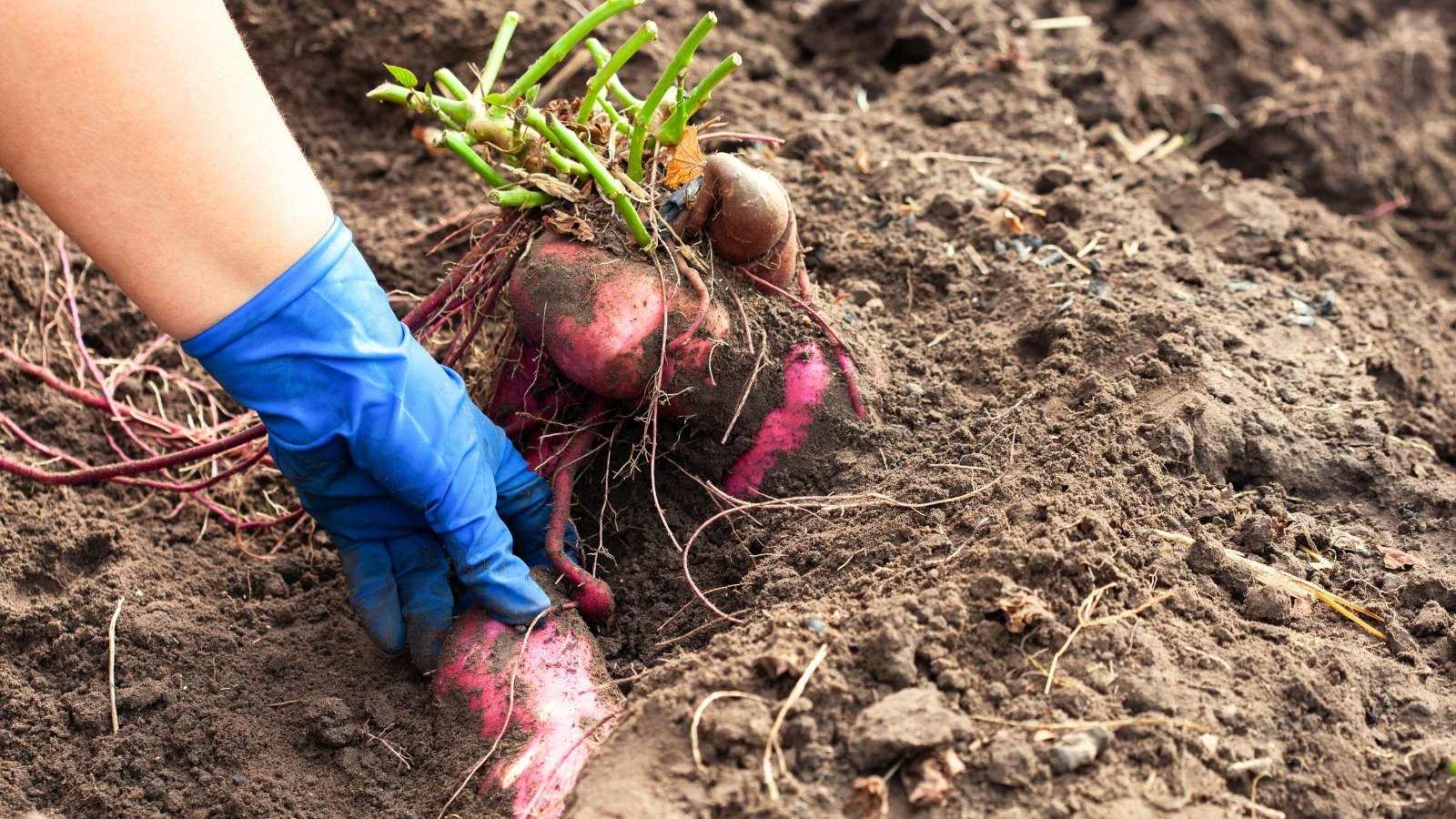 Cutting vines back helps get the roots out cleanly.
Cutting vines back helps get the roots out cleanly.When all signs point to ready spuds, trim the vines for easier harvesting. Cut them away to dig and lift the roots. If any leaves are still young and tender, don’t forget to pick them for fresh eating or tossing in cooked dishes. For large patches, mow the vines before digging.
To harvest, use a garden fork or spade to loosen the surrounding soil and lift the potatoes, taking care not to damage tender skins. Separate any soil clumps from the roots, but hold off on rubbing or washing away the dirt until after curing and storing.
You can wash, cook, and enjoy freshly harvested sweet potatoes close to picking time. Curing and storing let their sugar content increase for the best flavor.
Curing
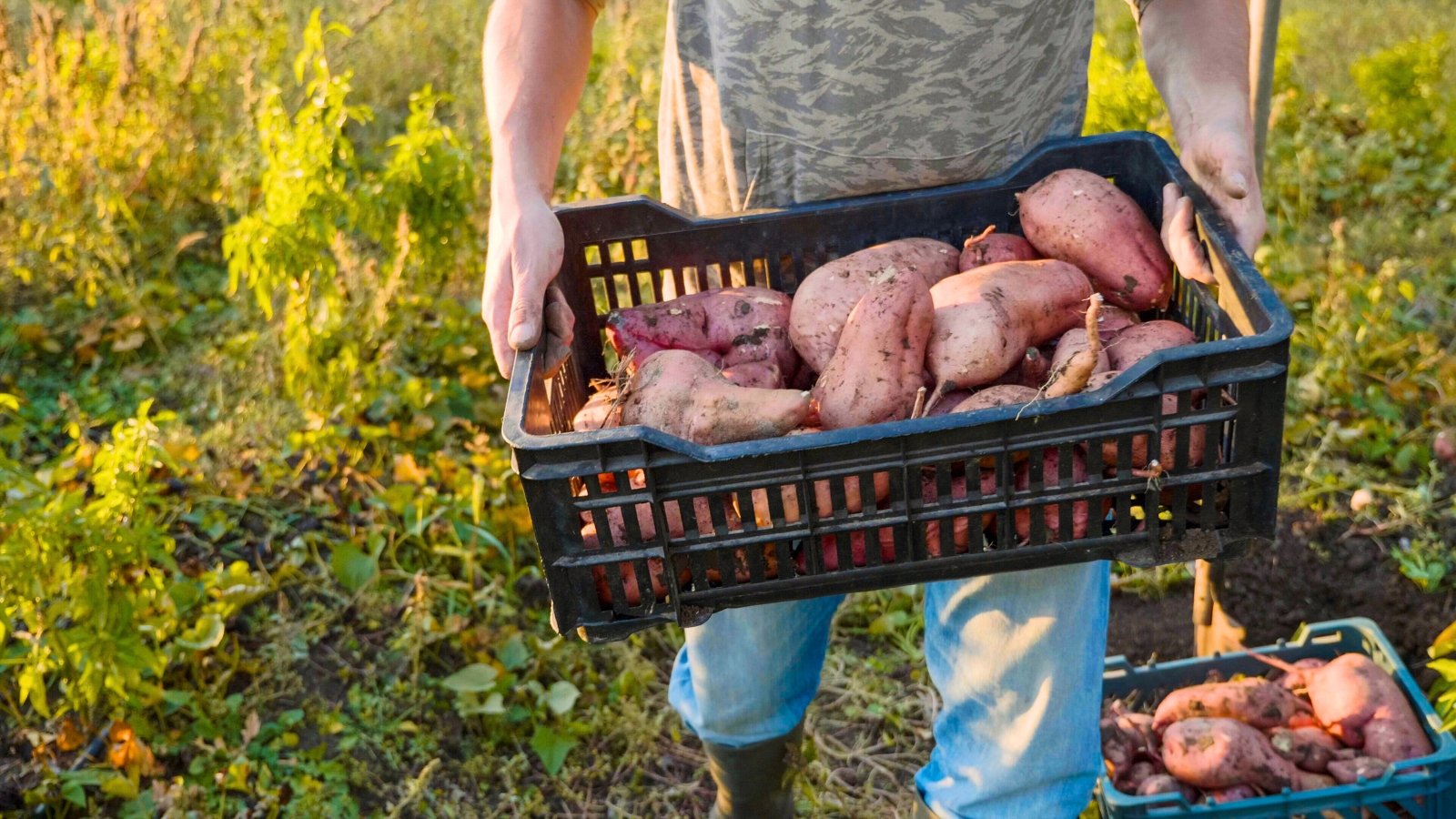 Proper curing means sweeter flavor and longer storage.
Proper curing means sweeter flavor and longer storage.After harvesting, sweet potatoes become sweeter with curing. Cure them for a week or two in a warm, humid location so they convert starches to sugars (become sweeter) before enjoying or storing.
In the home garden, a porch, shed, or garage may work for curing. Harvesting in late summer when humidity and temperatures are still high makes for good curing. The conversion won’t occur in temperatures below 70°F (21°C).
Temperatures near 85°F (29°C) with a humidity of 80-90% are optimal for curing. A week in a warm, humid spot does the trick. Spread the potatoes in a single layer to cure. Sweet potatoes store without curing, but it helps the flavor and seals any callouses or cuts that can lead to rot during storage.
You can also cure sweet potatoes by leaving them in the ground for a few days after clipping the vines. Take care not to expose them to overly wet or cold conditions as they sit, which causes decay and rot issues.
Storing
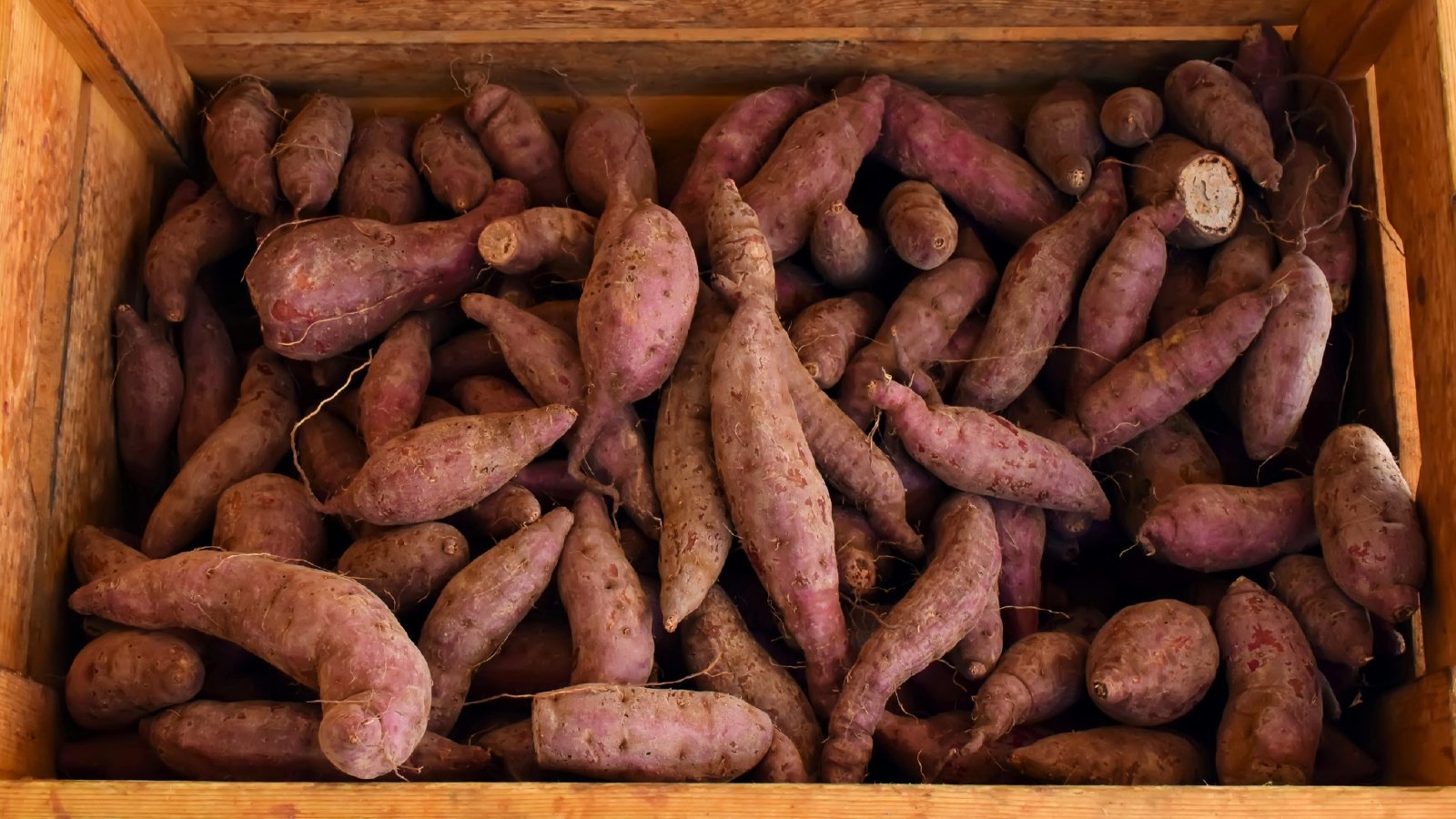 Proper airflow and temperature mean happy stored veggies.
Proper airflow and temperature mean happy stored veggies.The vegetables store for over six months in a cool space like a root cellar or basement. Optimal storage temperatures are 50 to 60°F (10-16°C) with 85-90% relative humidity. Store them in ventilated baskets, crates, or boxes.
If the temperatures are too warm, the roots sprout and shrivel. Avoid refrigerating sweet potatoes, too, as temperatures below 50°F (10°C) can cause off-flavor and even rot.
Freezing
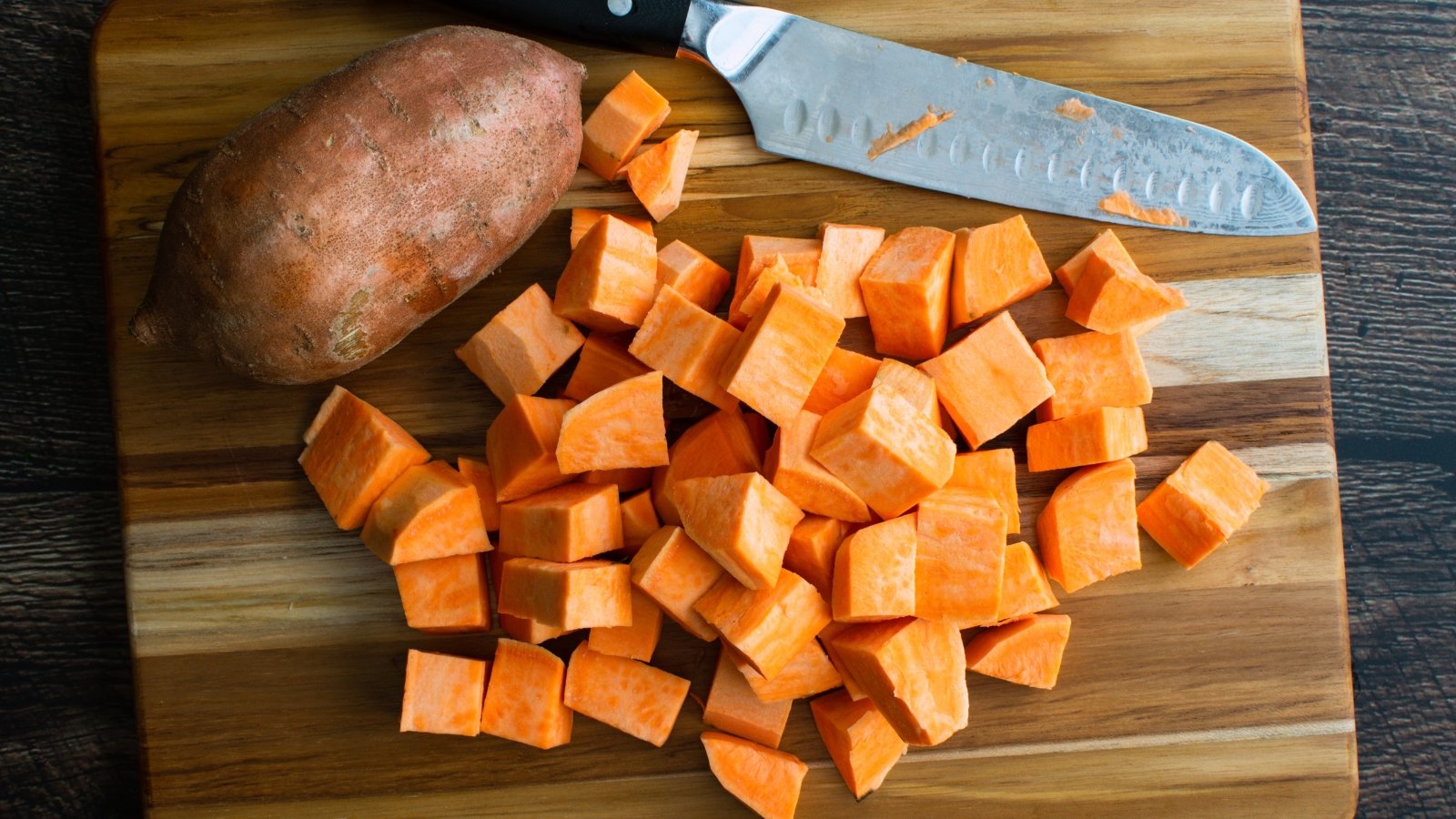 Cool cooked roots completely before packing for freezing.
Cool cooked roots completely before packing for freezing.For gardeners with a bounty of potatoes and nowhere to store them, freezing is an option for lasting enjoyment. Cook the potatoes until near tender via steaming, baking, and boiling, and let them cool at room temperature. Peel and slice or mash for freezing.
Lemon juice helps keep the potatoes from darkening. Dip slices for five seconds in a solution of ½ cup lemon juice and one quart of water. For mashed potatoes, mix in one tablespoon of orange or lemon juice per quart of potatoes.
Pack them into an airtight container or sealable bag for freezing, leaving half an inch of headspace.


 5 days ago
32
5 days ago
32





















 English (US) ·
English (US) ·  French (CA) ·
French (CA) ·